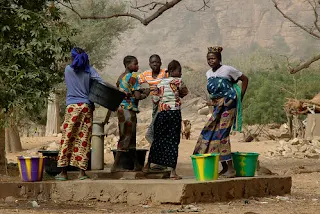Mali From 500 A.D. to 1960
Journey Through the Ages From Mali Empires to Mali Independence
Mali, a former French colony, is a landlocked country in West Africa. It's about the size of California and Texas combined. The region that makes up Mali today has a fascinating history.
It was a crossroads for people from the Mediterranean coast, the desert in the north, and those from the tropical south. Three major empires dominated this region in the past: Ghana, Mali, and Songhai.
Ghana, Mali, Songhai: The Magnificent Empires of Ancient Mali
The Ghana Empire thrived from around 500 A.D. to 1200 A.D. and covered present-day Mauritania, Senegal, and Mali. It spanned the gold-producing forest region and the southern terminus of the caravan trade route. The empire's wealth came from trading in gold, slaves, and salt.
In the 11th century, the Almoravids, a Berber dynasty that also conquered Spain, weakened Ghana, paving the way for the Mali Empire, which emerged around 1200.
At its height, Mali stretched from the upper Niger in the south to the Sahara in the north and from the Senegal River in the west to Gao in the east.
Mali was primarily agricultural, cultivating crops like millet, rice, and fonio. Trade remained crucial, and Islam spread with the support of Malian rulers.
However, the Mali Empire's power waned due to succession disputes in the late 14th century, allowing the Songhai, based around Gao, to overthrow it and establish their own state.
From 1493 to 1528, the Songhai Empire became the largest in West African history, centered in Gao and with Timbuktu as its religious and intellectual hub. Like its predecessors, Songhai was a prosperous but socially stratified society.
In the late 16th century, the Songhai Empire faced a significant upheaval when a formidable Moroccan army invaded the region. This invasion, led by the Saadian dynasty from Morocco, marked a critical turning point in the history of the Songhai Empire.
The Moroccan forces, armed with advanced weaponry and tactics, clashed with the Songhai warriors in a series of battles. Ultimately, the Moroccans defeated the Songhai forces, severely damaging the empire's stability and power structure.
Following the Moroccan invasion and the fall of the Songhai Empire, the region descended into a prolonged period of political and social turmoil.
With the once-mighty empire in disarray, various factions and local leaders vied for control of the territory. This power vacuum led to a fragmented and unstable landscape marked by conflicts between rival groups.
External pressures from neighboring states and European colonial interests further complicated the situation. This era of uncertainty and instability set the stage for significant changes in the region's political dynamics as different entities sought to assert their influence and control over the lands once governed by the Songhai Empire.
During the period of French colonial administration, Mali went by the name of French Sudan.
Under French colonial rule, Mali was known as French Sudan. It was administered from the town of Kayes from 1892 to 1899.
Kayes oversaw many aspects of colonial control as the administrative hub, including taxation, infrastructure development, and implementing French policies in the region.
The town's strategic location on the Senegal River made it a practical choice for colonial administration, as it facilitated communication and transportation throughout the area.
Mali gained independence from France on June 20, 1960, initially forming the Federation of Mali with Senegal. However, Senegal seceded two months later, and on September 22, 1960, the Republic of Mali was established under President Modibo Keita and the Union Soudanaise party. Mali also withdrew from the French Community and the Franc Zone.
Mali's Saharan Frontier Timbuktu and Beyond
Mali's northern third is geographically within the Sahara Desert, although the desert has been encroaching southward.
The rest of Mali is part of the Sahel, a dry transition zone between the true desert and the more hospitable savanna. Rainfall is scarce throughout the country.
Mali is traversed by two major rivers: the Niger and the Senegal. The Niger River flows through the heart of Mali, from Guinea to Niger, passing through cities like Mopti, Timbuktu, and Gao.
During the rainy season, it forms a vast inland delta between Ségou and Timbuktu. The Senegal River covers a smaller portion of Mali's western region.



